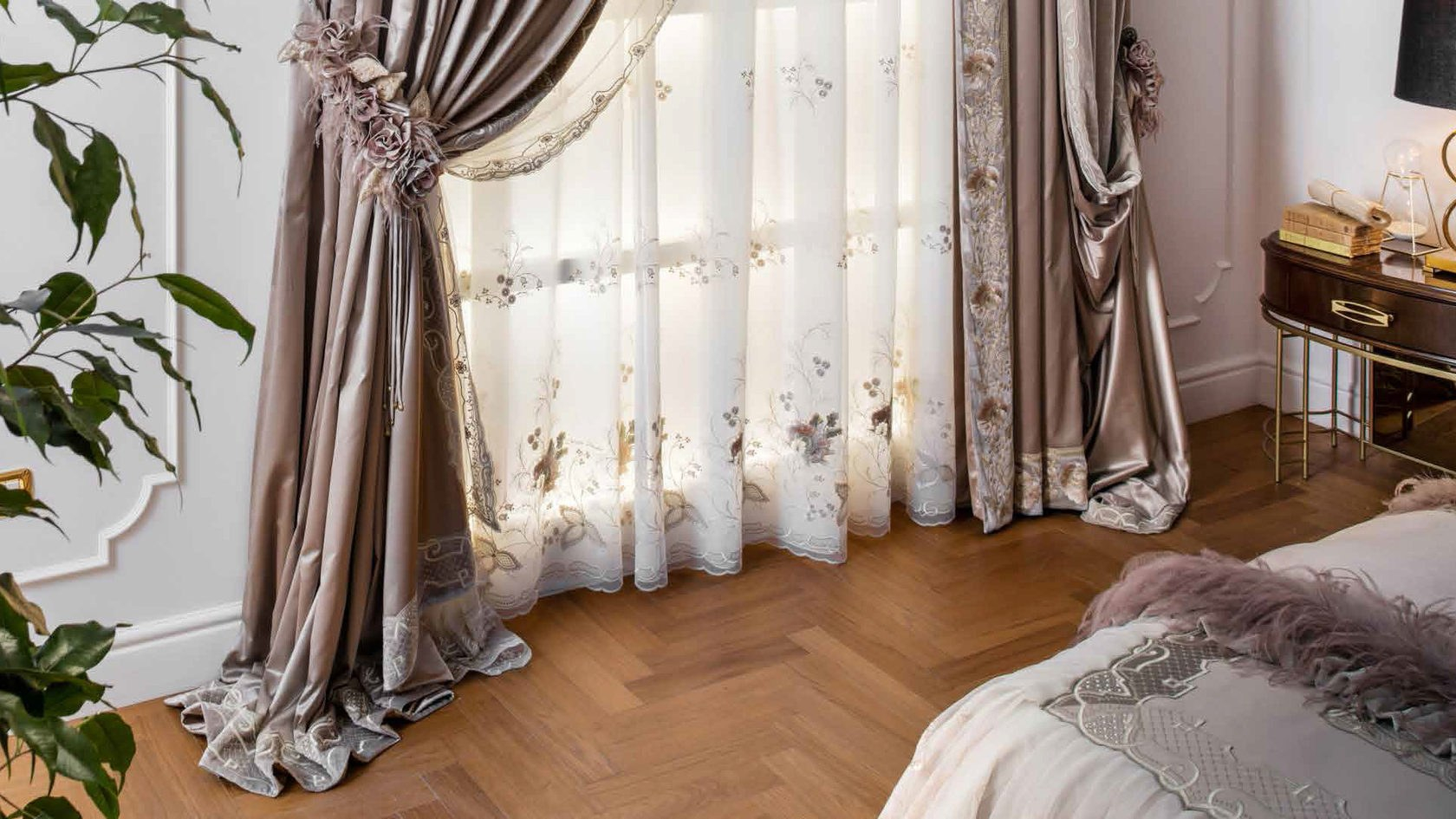Should Curtains Gracefully Touch the Floor or Float Above?
Deciding on the ideal curtain length is one of the key questions when designing any window treatment. Are curtains supposed to touch the floor or is it better to have them hovering an inch or two above? When it comes to whether curtains should touch the floor, there are pros and cons to weigh regarding both aesthetics and functionality.
To help you determine if allowing your drapes to graze the floor is the right choice for your space. From factors like room proportions and style to practical considerations around safety and maintenance, we’ll provide the information you need to make an informed decision. You may find that slightly elevating your curtains works best, while in other rooms, the elegance of curtains just kissing the floor perfectly complements your decor.
We’ll walk through everything you need to know, from ideal curtain lengths to specialized hardware, so you can achieve a polished, professional look with long curtains. Follow along as we delve into the art and science of mastering floor-length styles!

The Art and Science of Measuring Curtains
Installing the perfect floor-length curtains requires both artistry and precision. To achieve an elegant, polished look, careful measurements are key. There are several important factors to consider:
First, assess your window height, sill depth, and ceiling height. Tall windows that extend to the ceiling call for extra-long curtains, while shallow sills and low ceilings may be better suited for subtly puddled curtains hovering just above the floor. Take detailed measurements to understand the exact dimensions you’re working with. This will inform optimal rod placement and projected curtain length.
Next, decide on your ideal hanging height and length. Curtains mounted high and close to the ceiling draw the eye up and can make rooms feel more expansive. For floor-length styles, factor in additional inches below the rod for optimal puddling or pooling.
Graceful gathered folds that just kiss the floor create a soft, romantic vibe. Or choose curtains long enough to puddle more dramatically in luxe waves across the floor, infusing rooms with laidback elegance.
When selecting floor-length window treatments, consider both aesthetics and functionality. While long curtains make a glamorous statement, maintain their elegance by allowing ample clearance so fabrics don’t drag or get damaged. Weighted hems help keep shape and prevent messy bunching around feet. Ensure flowing curtains don’t obstruct pathways or pose tripping hazards. Find the perfect balance for your space.
Use handy measuring tips and tricks to make hanging floor-length styles a breeze. First test curtains by temporarily pinning them to the desired height and length when mounted on rods. This helps visualize proportions before permanent alterations.
Make small adjustments to get the exact custom floor sweep you want. For more accuracy, enlist a helper to hold rods at varying heights as you preview the look.
Once ideal dimensions are determined, use clips to neatly mark curtain lengths along top edges and hems prior to cutting. When hemming to size, allow an extra 1/2 inch to account for natural shrinkage after laundering. Install extended-length hardware that protrudes several inches outside windows for stabilizing very long curtains. Attach sufficient rings or grommets spaced no more than every 6 inches to prevent sagging. Follow these techniques for expertly executing floor-grazing designs.
Deciding on Curtain Length: Design Factors to Weigh
Choosing the perfect curtain length requires carefully weighing several key design factors:
Aesthetics
Floor-sweeping curtains infuse rooms with drama and height. The billowing folds that gracefully puddle on the floor create an elegant, polished look. Consider your overall decor style – bold sweeping curtains pair well with opulent, luxurious interiors, while subtly kissing the floor for a soft romantic vibe.
Functionality
- Floor-length curtains excel at blocking light and boosting privacy.
- The added material also provides better insulation and temperature control.
- But make sure lengthy fabrics don’t obstruct pathways or make windows difficult to open and close.
- Find a length that maximizes function without sacrificing style.
Safety
Curtains that fully pool on floors can easily get tangled underfoot. Seek out those with discreet weighted hems to help keep shape and stay put. Allow several inches of clearance so fabrics don’t drag and cause tripping hazards. Consider vacuuming ease as well.
Maintenance
The extra yardage of floor-length curtains typically necessitates professional laundering. Select fabrics like washable cotton and linens that hold up well to frequent cleaning. Periodic steaming and pressing may be needed to keep long curtains looking their best. Plan for alterations as curtains age and if lengths need adjusting.
Special Considerations for Long Curtains
When working with floor-length curtains that puddle dramatically, some special considerations come into play:
Prevent Sagging
The weight of heavy, long fabrics can cause curtains to droop and sag over time. Attaching weights or weighted hems helps add stability to keep floor-length curtains hanging straight. Choose discreet weights in coordinating colors that blend in. Sew into the bottom hems or use inconspicuous weighted tapes inside the lower edges. The right amount of subtle weighting helps curtains hold their shape beautifully.
Allow for Graceful Draping
While sagging should be minimized, allow for some soft draping and billowing. Floor-length curtains shouldn’t be too stiff or hang overly taut. Enable fabrics to drape gracefully for that luxurious pooled effect. But prevent unseemly bunching around curtain bases using discreet weights. Find the optimal balance between gracefully draping folds and shapelessness.
How Much Should Curtains Touch the Floor?
For the most elegant look, floor-length curtains should just lightly kiss the floor. Allowing 2-3 inches of extra length below window sills enables curtains to subtly puddle without dragging. The goal is a gentle sweep along the floor, not heavy pooling. This maintains the beautiful draped effect without posing tripping risks or damaging fabrics.
Secure Rods Properly
To support heavy long curtains, extend rod brackets several inches past window frames. This helps stabilize weight load and reduce stress on mounts. Sturdy bracket rods and poles designed for floor-length curtains provide the strongest support. Or install types of curtain rods and tracks rated for heavier drapes. Follow any provided hardware instructions carefully. Mount into studs for added strength whenever possible.
Adjust Lengths Correctly
Getting floor-length dimensions perfect can take some finesse. Hang curtains from desired mounting height, then adjust lengths as needed. Temporarily pinning hems while testing allows customizing the exact puddle and sweep. Take care not to cut it too short! Leave an extra inch or two to account for settling. And only make the final trimming after steaming curtains for the first time. These measuring tips help nail perfect floor-skimming lengths.
When done right, long curtains should gracefully kiss the floor while maintaining their shape and hanging. Weighing down hems, using sturdy hardware, and customizing lengths prevents unsightly sagging.
Tips for Installing Perfect Floor-Sweeping Curtains
Getting floor-length curtains to hang just right requires some finesse. Follow these pro tips for executing the look flawlessly:
Should Bedroom Curtains Touch the Floor?
Floor-length curtains can make a stunning statement in bedrooms. But take care to allow adequate clearance so fabrics don’t tangle around feet when getting in and out of bed. For safety, bedroom curtains should just lightly graze the floor.

Mark Lengths During Test Hanging
Before hemming or cutting long curtains, the first test hang them from desired mounting height. Temporarily secure with pins, allowing extra inches below windowsills for optimal floor-sweeping. Step back and visualize proportions. Mark ideal curtain length along lower edges with pins.
Customize Lengths as Needed
Use the pin markings from test hanging to guide where curtains should be hemmed. Leaving them a touch longer accounts for minor shrinkage and settling over time. Steam curtains before making any final length adjustments. Painstakingly customizing lengths helps achieve perfect floor-skimming drama.
Extend Brackets for Stability
Extra long brackets that protrude several inches outside windows provide critical support for heavy floor-length curtains. The added arm length helps stabilize larger rods under curtain weight load. Reduce hardware strain and sag risk by always opting for extended brackets with long drapes.
Attach Clips and Rings Properly
Prevent gapping and drooping by attaching enough rings or grommets along curtain tops. Clips should be spaced every 4-6 inches. Alternatively, sew channels for curtain weights into the hem circumference instead of just at the corners. Follow all hardware instructions for properly distributing and attaching clips or rings to keep floor-length curtains hanging neatly.
With the right techniques, achieving an elegant floor-length curtain look is totally doable. Mark lengths during test hanging first. Then customize hems accordingly, use extended hardware, and mind ring spacing. Follow our tips for flawlessly executing the art of installing floor-sweeping curtains in any space!
By following our tips for assessing windows, planning rod placement, and customizing curtains, you will certainly master the art and science behind the polished look of floor-sweeping styles!